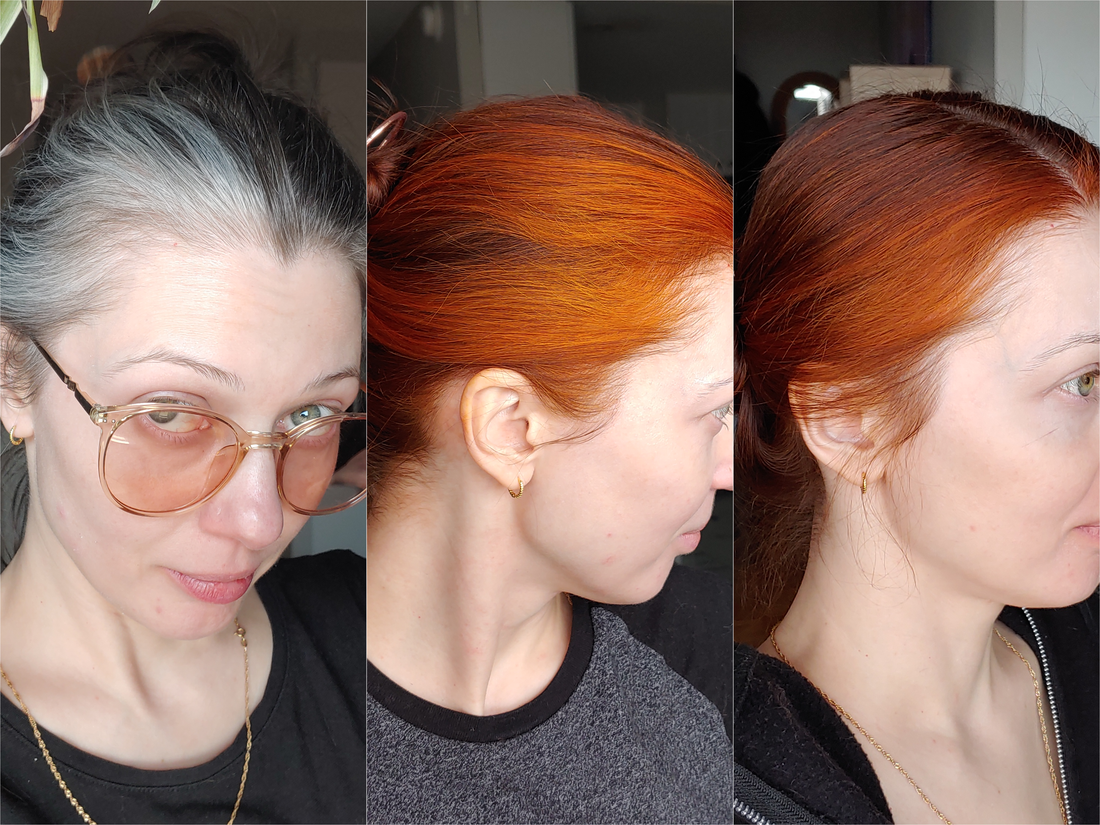
I Dyed my Silver Hair Copper with Henna
Share
While I typically write about putting pigment on canvas, today I'm sharing a different kind of colour transformation - using henna to turn my silver hair copper. Here's my experience using this ancient plant dye, and why I chose to make the change.
Though my silver hair looked acceptable when styled, I never felt truly excited about it. It was more of an "okay, I can make this work" rather than an enthusiastic "Yes!" While I loved how the truly silver parts looked, combined with my natural brown, the overall effect was washed out and dull. My temples looked particularly sparse since the silver hairs were translucent and individually almost invisible.
After contracting COVID early in the pandemic, before vaccines were available, I experienced a moderate case where I struggled to breathe until my lips turned slightly blue. I later developed long COVID, though I only realized this in hindsight. As a result, my hair fell out for about two years. (This is called Telogen Effluvium and can be caused by any stressor, from a bad breakup to a viral infection.) While it's now growing back with numerous shorter pieces, these areas of short hair are made more obvious by the silver colour. Each time I looked in the mirror, though I was grateful for the regrowth, I didn't want to be reminded of illness, the challenging experience of hair loss, and the overall stress of recent years. I wanted my hair to look full and dense, with the shorter pieces blending seamlessly.
I landed on henna mostly for its secondary benefits. As it dyes the hair, it coats and strengthens it, which has the effect of thickening the individual hairs and making them stronger. It works like a protein treatment. It's also great for scalp health. I am prone to seborrheic dermatitis, which is a kind of scalp eczema, where my skin overreacts to a naturally occurring fungus we all have on our skin called Malassezia. Henna is able to clear up fungal infections, so I thought it would help with this condition too. It also helps with hair loss and hair growth by inhibiting DHT. And I just plain liked that it's just a ground-up plant. I am all for the latest science, but sometimes nature gets it right.

This is a goodbye and thank you to my silver hair. I won't be seeing you for a while, and I thank you for growing so silver and sparkly. For existing at all. For growing long and in the same general pattern as the rest of my hair. For returning to me after COVID and long COVID. For drawing attention and questions to me, for people asking me if it's natural. For sometimes helping me feel kinda trendy. You will still be there under the dye, I hope getting healthier and longer. And in a few years, I might put you on full display again. But for now I want to strengthen and protect you. And make you easier to style so that I can let you rest more day to day, without fussing with you so much. Hairs, I love you and I thank you for continuing to grow. And I will continue to do my best to take care of you.


I applied the henna in sections using my gloved hands, putting it on quite thick because I was afraid of missing pieces. I started from the back and moved up and forward. When I finished all the henna in the bowl, there were still two sections of hair that were bone dry. I had a moment of panic - I knew I couldn't wait another two hours to activate another batch! But I calmed down and realized I could redistribute some henna from other sections, adding a little water to help. It worked, but I don't suggest following my example. Just make 1.5x what you think you'll need and freeze the leftover for roots.
It smells kind of like grass, and a little like old leaves. I liked the smell, and I didn't find it too strong. I fully preferred it over box hair dyes which always stung and burned my eyes. I had also added some essential oils to the mix.

I looked really silly as the henna was processing on my head. Quite a look with the shirt covered in mud and the plastic and toque on my head. There is no way I would go out like this... But here you go, internet, enjoy!
I let the henna process on my head for 3 hours. I am lazy and always want the fastest and easiest route possible. Three hours seems to be the absolute minimum for henna on grey.
Even though I had read about it and was somewhat mentally prepared, I still felt the "Orange Panic" that came when I first saw the dye result. The picture below is the following morning, but it was even brighter than that the first evening after I washed it out. It was true Ronald McDonald Orange! I also had a slight orange stain on my ears and hairline. But I knew from my reading that this would all settle down in the next 3-7 days. I was so relieved when I saw it the next morning and it was darker!

It continued to settle and deepen over the next week.
2nd day

3rd day

7th day

I am wearing my hair parted slightly differently in the 7th-day photo, but you can still see at my temple how much darker it had gotten. Also, I now match my cat!
The greys that were orange are now a nice copper red, looking natural with beautiful colour variation and streaking. It really looks like naturally growing red hair. My hair feels thicker and stronger, and surprisingly, my waves actually hold and show better.
Looking at my photos later, I noticed I'd missed a few hairs at my temples during application - something to be more careful about next time.
I love how my scalp is no longer super visible through the silver hairs and I feel like I can part it however I like instead of trying to be strategic and avoid putting a part in the silver areas because that makes my scalp too visible. Now I just part wherever I feel like and it looks alright.
Regarding scalp health, this felt lovely going on - cooling and comfortable. The rinsing process was manageable, though I had a few areas where small henna particles remained, causing mild itchiness (still less than seborrheic dermatitis). Everywhere I rinsed thoroughly feels calm and healthy, an effect that's continued with my usual hair care routine.
To rinse it out, I basically took a bath and put my head under the water and gently waved it around to get the mud-like plant particles out. I used my hands to loosen everything. I was worried that doing a bath like this would also end up staining my skin, but the plant particles are so diluted and you're in the tub for such a short time, that this just doesn't happen. I followed this with a shower and heavy application of conditioner, all the way up to my scalp, then rinse, then another application of conditioner, until it felt like there weren't any more particles in my hair. Then I rinsed and rinsed.
I did henna on my hair not just for the colour but also for the secondary benefits. They were a very large part of why I did it. Henna helps with scalp issues, including seborrheic dermatitis and dandruff. It helps to thicken and protect the hair by putting a coating on it, and it helps with hair loss and hair growth by inhibiting DHT.
And I can attest to already feeling the scalp healing and hair thickening properties. I am happy with the colour and like seeing myself in the mirror with it. I find my hair easier to style and I have to think about it less.
I think having grey hair is beautiful but because I'm growing out my hair after COVID hair fall, I have lots of short pieces that fly away and looked really messy with grey hair, but now blend in a little more and are less noticeable.
I'm glad I can still fully see where my grey hair is through the henna. I look forward to having long healthy hair and once I see that all the shorter hairs have caught up in length to the rest of my hair, I might transition back to silver. The way I think I'll do this is by slowly adding a little more cassia to the henna mix every time I do my roots. This way the red will gradually lighten to strawberry, then to warm blonde, then finally back to grey.
But this won't be for a few years and since my goal right now is long healthy hair, I just want to keep going with henna. Also, when I do my roots next I plan on also doing my eyebrows!

I'm really happy with how this turned out. While it requires effort, the process feels like a pampering experience. It's not a decision to make lightly - unlike modern hair dyes, henna is much harder to remove, especially if mixed with indigo for brown or black colours (which can turn green when bleached). This is why I chose pure henna, which can be lightened with bleach, removed with vitamin C treatments (with persistence and repeated applications), or dyed over with modern dyes. Just make sure to buy a pure henna powder without any additives.
My favourite sources for learning about henna for hair:
PDF book on Mixing Henna (can also be found on the Reddit board mentioned above)
My artwork on silk scarves, available in my shop. Do you think the artwork complements the copper tones? Click each photo to shop the scarf shown.




